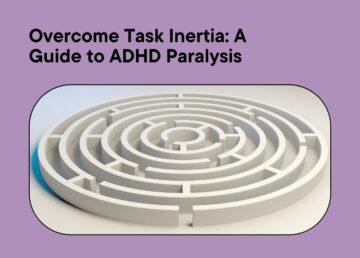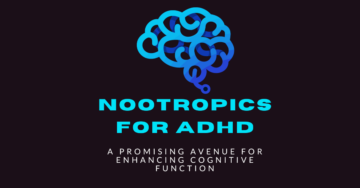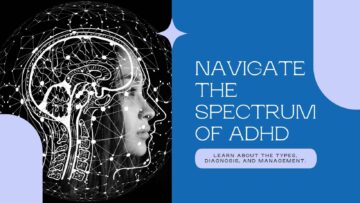
Attention deficit hyperactivity disorder (ADHD) is a neurodevelopmental condition impacting children and adults. This prevalent mental disorder is characterized by a persistent pattern of inattention, hyperactivity, and impulsivity, which can hinder daily functioning and personal development.
Statistics from the American Psychiatric Association (APA) reveal that approximately 8% of children and 2.5% of adults worldwide are affected by ADHD, making it a significant concern for mental health professionals and families alike.
In this article
Understanding ADHD: An Overview
Attention deficit hyperactivity disorder (ADHD) can be categorized into 3 main types: primarily inattentive, primarily hyperactive-impulsive, and combined presentation.
Inattentive ADHD involves difficulty sustaining attention, following instructions, and organizing tasks, while hyperactive-impulsive ADHD leads to excessive fidgeting, restlessness, impulsiveness, and difficulty waiting for one’s turn.
Combined presentation ADHD encompasses symptoms of both inattentiveness and hyperactivity-impulsivity.
The impact of ADHD on one’s life can be profound. Academic performance may suffer in children and young adults, and challenges may arise in forming social relationships.
Similarly, adults with ADHD may encounter difficulties in time management, organization, and maintaining stable employment, which can also affect their relationships and overall mental health. This underscores the significance of early recognition and intervention.
The exact cause of ADHD is unknown. Research suggests it’s genetic and can run in families; therefore, if you feel like you may have it, consider checking your family’s medical history and discussing it with your family members.
While environmental factors don’t cause ADHD, they may contribute to its development. Some studies suggest that children of women who smoked during pregnancy were more likely to experience symptoms of ADHD.
Recognizing ADHD Symptoms
ADHD symptoms in children often become apparent in early childhood and may persist into adolescence and adulthood.
Some common indicators include frequent forgetfulness, difficulty staying focused on tasks or play activities, and struggling to follow instructions or complete assignments.
Identifying ADHD symptoms in children
ADHD symptoms in children often become apparent in early childhood and may persist into adolescence and adulthood.
The following symptoms can persist after growing up:
- frequent forgetfulness,
- difficulty staying focused on tasks,
- unable to do leisure activities quietly,
- makes careless mistakes,
- struggling to follow instructions or complete assignments,
- finding it difficult to stay seated.
Inattentiveness and its indications
Inattentiveness in younger children with ADHD can manifest as being easily distracted during schoolwork or playtime, frequently losing belongings, having difficulty listening to guardians or teachers, and being forgetful in daily activities.
Hyperactivity and impulsiveness: How they manifest
Hyperactive and impulsive ADHD can lead to constant fidgeting, excessive talking, difficulty staying seated, impatience, blurting out answers, or interrupting others. This can negatively impact their social life and make it more difficult to befriend other children.
ADHD Symptoms in adults
Adult symptoms of ADHD, while similar, may differ from those in children.
While hyperactiveness may decrease with age or become more manageable while growing up, inattentiveness often persists.
Many adults experience chronic disorganization, restlessness, impulsivity, and difficulties with time management, completing daily tasks, and meeting deadlines. They’re also more prone to mood swings and may have difficulties completing forms, preparing reports, and dealing with paperwork in general.
Moreover, adult ADHD can affect how adults deal with their condition. They might lean toward unhealthy coping mechanisms, such as alcohol and substance abuse.
ADHD Symptom Checklist
ADHD symptoms may vary in severity and presentation from person to person. Some of the most common signs include:
- Inattention: Easily distracted, forgetful, difficulty sustaining focus. This can lead to trouble at work, problems with studying, and issues with interpersonal relationships.
- Hyperactivity: Constant restlessness, fidgeting, difficulty engaging in quiet activities. While its external symptoms might decrease with age, people report undergoing internalized hyperactivity or mental restlessness, which can manifest through racing thoughts, anxiety, agitation, getting bored quickly, and craving excitement.
- Impulsivity: Acting without thinking, interrupting conversations, difficulty waiting for one’s turn. Adults can often find themselves taking unnecessary risks.
- Signs of inattentive ADHD
While the symptoms for adults with the disorder are clearly defined, forgetfulness and inattention can be experienced without having ADHD. Lack of sleep, poor rest, stress, burnout, and other mental health conditions can affect cognitive functioning.
However, some examples can help you understand whether you have inattentive ADHD:
- Frequently losing various items – keys, phone, work-related papers, etc.
- Struggling to complete tasks or follow through with instructions as they cause mental devastation.
- Becoming easily bored or avoiding tasks that require sustained mental effort. However, it can be hard to stop working on enjoyable projects like hobbies, video games, or researching liked topics. In other words, you might hyperfixate on tasks that give you pleasure.
- Forgetting projects and meetings.
Indicators of hyperactive and impulsive ADHD
Hyperactive children can usually be spotted easily. However, while growing up, people learn certain behaviors and how to act in certain situations appropriately – adults with ADHD can often mask their hyperactive ADHD symptoms, especially around others.
There are some signs of hyperactive-impulsive manifestation:
- Excessive talking, even in inappropriate situations.
- Difficulty remaining seated, constantly moving, or fidgeting (shaking one’s leg, playing with hair, chewing lips, etc.)
- Acting on impulses without considering potential consequences – impulsive spending, risky relationship behavior, etc.
Beyond Typical Behavior: Distinguishing ADHD
Recognizing the symptoms can be challenging as some behaviors may be mistaken for typical childhood or adult fluctuations or personal characteristics.
However, early detection is crucial for timely intervention. Seeking professional guidance when ADHD symptoms significantly impact daily life can lead to appropriate support and management.
Diagnosing ADHD
Centers for Disease Control and Prevention (CDC) suggests healthcare professionals use the criteria defined in the Diagnostic and Statistical Manual of Mental Disorders (DSM-5) by the American Psychiatric Association.
As outlined in the DSM-5, specific symptoms must be present for at least 6 months and interfere with daily functioning. The criteria for ADHD diagnosis are:
- At least six symptoms of inattention. The individual fails to pay close attention to details, makes careless mistakes, finds it difficult to maintain attention in demanding tasks, seems not to listen when spoken to, is forgetful and distracted by external stimuli.
- Six or more symptoms of hyperactivity. For example, trouble waiting for one’s turn to act or speak, trouble listening to and paying attention to directions, talking excessively, fidgeting, and difficulty staying still.
- Symptoms across multiple settings. The inattentive symptoms should be present in at least two or more settings – home, school, or work – to rule out situational factors.
- Symptoms interfere with functioning. The persistent symptoms must lead to impairment in academic, occupational, social, or day-to-day activities, affecting the person’s ability to meet their potential. These could be forgetting to make or return phone calls, difficulty paying attention in classes, and conversations, etc.
- Symptoms are not better explained by other disorders. ADHD diagnosis fits the situation best, and symptoms cannot be better explained by related conditions (mood disorder, anxiety disorder, personality disorder, etc.)
It’s essential to note that the diagnosis of the disorder should be based on a comprehensive evaluation conducted by a qualified healthcare professional who has experience in assessing and treating ADHD.
Options for treatment
Learning how to manage forgetfulness, creating strategies for coping with monotonous tasks and sustaining attention, and releasing excess energy are vital for comfortable living and better mental health.
The symptoms can be successfully managed with the help of medication, such as Adderall, Ritalin, or Concerta. However, not every person can take ADHD medication – you might be advised against using it due to side effects or incompatibility with other drugs.
But, there are other techniques to reduce the symptoms. One of the most popular ways to manage ADHD and other mental disorders is cognitive behavioral therapy (CBT). CBT focuses on teaching you the required skills and healthy coping mechanisms to tackle the symptoms and reduce frustration. We have compiled a list of different apps which can help to treat some of the symptoms.
Sensa for ADHD
Sensa is a cognitive behavioral therapy (CBT) based app that can help individuals with attention deficit hyperactivity disorder as well as other mental disorders. The app provides tools to help you manage symptoms effectively, build routines, improve time management, learn coping skills, and enhance overall self-control.
Sensa is created with the help of mental health professionals and can provide techniques to ease various mental health condition symptoms. It can be used by those with an official ADHD diagnosis or those suspecting they might have it.
Co-Existing Conditions and Related Issues
Often, ADHD is followed by other mental health conditions in children and adults. Prevalent symptoms can lead to feelings of anxiety and depression. Additionally, individuals with autism spectrum disorder (ASD) also tend to have ADHD.
Common conditions in children with ADHD
Children with ADHD often experience comorbidities such as learning disabilities, oppositional defiant disorder (ODD), anxiety, and depression.
Addressing these related issues alongside ADHD is essential for comprehensive treatment.
Common conditions in adults with ADHD
Adult ADHD symptoms are less researched and more difficult to characterize. In adults, ADHD may be associated with anxiety disorders, drug or other substance abuse, and substance misuse.
Besides anxiety disorders, adult ADHD is also associated with personality disorders, obsessive-compulsive disorder (OCD), and mood disorders like depression.
Because of this, many adults with the disorder have difficulties in maintaining stable relationships and employment.
When to Seek a Healthcare Professional’s Help for ADHD
Recognizing the need for a doctor’s evaluation is crucial. Self-assessments and self-help tools like Sensa are excellent and can provide clarity about your well-being, as well as benefit symptom management.
However, consulting a mental health professional is necessary when symptoms significantly impair daily activities, relationships, and functioning. This is especially relevant if you notice additional comorbidities. Primary care providers can also diagnose the disorder.
Healthcare professionals rely on the guidelines in the American Psychiatric Association’s Diagnostic and Statistical Manual to diagnose ADHD, discuss treatment options, and provide effective treatment for both children and adults with ADHD.
Living Happily With ADHD
Yes, ADHD symptoms can affect individuals across their lifespan and affect children and adults, but it does not mean that a mental health condition has to control your life.
Early recognition and intervention are crucial to ADHD diagnosis and managing the challenges posed by ADHD. With the right support, tools, and understanding, individuals can control the negative impact of ADHD, lead fulfilling lives, and achieve their full potential.
Remember, seeking help and embracing available resources can make a significant difference in managing symptoms and promoting your overall health and well-being. Diagnosis should not stop you from reaching your full potential!
References:
- Nichols, S.L. and Waschbusch, D.A., 2004. A review of the validity of laboratory cognitive tasks used to assess symptoms of ADHD. Child Psychiatry and Human Development, 34, pp.297-315.
- Shaw-Zirt, B., Popali-Lehane, L., Chaplin, W. and Bergman, A., 2005. Adjustment, social skills, and self-esteem in college students with symptoms of ADHD. Journal of attention disorders, 8(3), pp.109-120.
- Wilens, T.E., Biederman, J., Faraone, S.V., Martelon, M., Westerberg, D. and Spencer, T.J., 2009. Presenting ADHD symptoms, subtypes, and comorbid disorders in clinically referred adults with ADHD. The Journal of clinical psychiatry, 70(11), p.15333.
- Harrison, A.G., 2004. An investigation of reported symptoms of ADHD in a university population. The ADHD Report, 12(6), pp.8-11.
- Fedele, D.A., Hartung, C.M., Canu, W.H. and Wilkowski, B.M., 2010. Potential symptoms of ADHD for emerging adults. Journal of Psychopathology and Behavioral Assessment, 32, pp.385-396.
- Swanson, J.M., Schuck, S., Porter, M.M., Carlson, C., Hartman, C.A., Sergeant, J.A., Clevenger, W., Wasdell, M., McCleary, R., Lakes, K. and Wigal, T., 2012. Categorical and dimensional definitions and evaluations of symptoms of ADHD: history of the SNAP and the SWAN rating scales. The International journal of educational and psychological assessment, 10(1), p.51.




